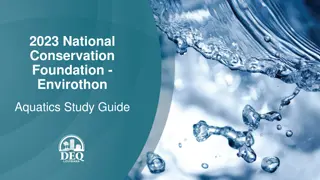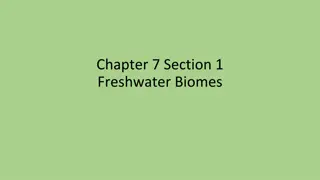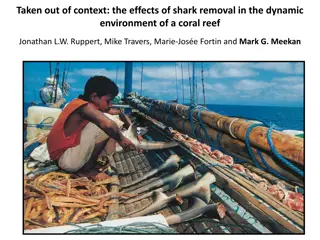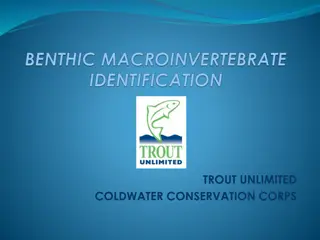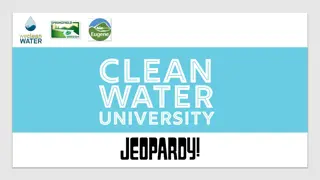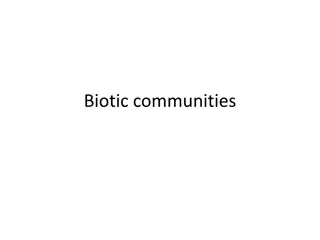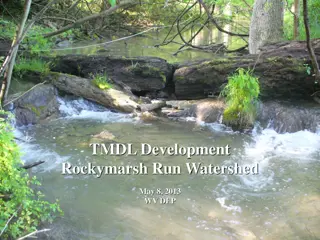2023 National Conservation Foundation - Envirothon
Explore the intricate dynamics of aquatic ecosystems and wetlands conservation through this comprehensive study guide. Discover the importance of watersheds, the hydrologic cycle, aquatic food webs, energy flow at trophic levels, and common macroinvertebrates in Louisiana. Learn about different wetl
3 views • 27 slides
Exploring Freshwater Ecosystems: Lakes, Ponds, and More
Freshwater ecosystems offer a diverse range of habitats, from lakes and ponds to wetlands and rivers. These ecosystems host a variety of organisms adapted to different zones based on factors like sunlight and nutrients. Plankton, nekton, and benthos are key aquatic groups, with unique roles in the e
0 views • 24 slides
Impacts of Shark Removal on Coral Reef Dynamics
This study delves into the repercussions of shark removal on the intricate ecosystem of coral reefs. It explores the correlation between shark abundance, reef fish community structure, benthic disturbances like cyclones and bleaching, and the synergistic effects of top-down and bottom-up processes.
1 views • 18 slides
Coldwater Conservation Techniques for Monitoring Water Quality in Trout Habitats
Learn about the Trout Unlimited Coldwater Conservation Corps' process for assessing water quality in trout habitats, including sampling techniques, taxonomic sequencing, and categorizing pollution tolerance levels of aquatic macroinvertebrates. Discover pollution-sensitive, somewhat sensitive, and p
0 views • 40 slides
Impact of Land Development on Stream Ecosystem Health in Mill Brook Preserve, NY, USA
The study focuses on the effects of land development on stream ecosystem health in the Mill Brook Preserve in New Paltz, NY. It discusses the degradation of water quality due to surrounding land development and the importance of macroinvertebrates as indicators of ecosystem health. The review of lit
0 views • 23 slides
Understanding Water Management in Urban Areas
Explore the journey of rainwater as it traverses streets, picking up pollutants, leading to its ultimate destination. Learn about the impact of pollutants like dog poop, fertilizers, and chemicals on water bodies. Discover the importance of water quality metrics, nutrients in soaps affecting waterwa
0 views • 33 slides
Ecological Consequences Assessment for Conservation Areas
Determining the ecological consequences of various scenarios is crucial for conservation efforts. The assessment focuses on changes in geomorphology, physico-chemical properties, fish populations, macroinvertebrates, and riparian vegetation. By evaluating scenarios based on ecological significance,
0 views • 11 slides
Understanding Biotic Communities and Benthic Ecosystems
Living organisms in an area form biotic communities categorized into producers, consumers, omnivores, detrivores, and decomposers. Aquatic organisms such as plankton, benthos, and nekton play vital roles. Benthic communities refer to organisms attached to or burrowing in aquatic ecosystems, influenc
0 views • 17 slides
Understanding Benthic Substrate Characterization Through Multibeam Bathymetry
Utilizing multibeam bathymetry and backscatter data, this project focuses on mapping potential benthic substrates in marine environments. The history, procedures, and possible classification schemes are discussed, highlighting the importance of analyzing backscatter data for sediment classification.
0 views • 28 slides
Understanding Total Maximum Daily Load (TMDL) Development in West Virginia
Explore the process of TMDL development in West Virginia, including background on water quality standards and impaired waters. Learn about the significance of TMDLs in maintaining healthy streams and the criteria for determining impaired streams, such as numeric and narrative standards. Discover how
0 views • 28 slides
